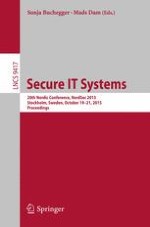2015 | Buch
Secure IT Systems
20th Nordic Conference, NordSec 2015, Stockholm, Sweden, October 19–21, 2015, Proceedings
herausgegeben von: Sonja Buchegger, Mads Dam
Verlag: Springer International Publishing
Buchreihe : Lecture Notes in Computer Science
